Annual Event list
Date
Event
Place
January
(Joya no Kane)
The Bells on New Year's Day (Joya no Kane)
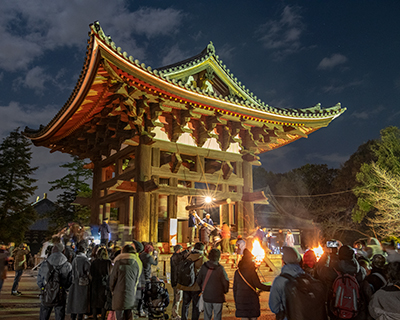
From 0:00 on January 1st, the Giant bell is rung 108 times at the Bell Tower. This ceremony is called “Joya no Kane”. The number 108 is supposed to be representative of the 108 worldly desires that a person experiences throughout the course of their entire life. At Tōdai-ji temple, a monk rings the first bell, and next, about 6 – 8 people ring the giant bell together once so about 800 people can ring the bell. From 22:30 on New Year’s Eve, numbered tickets are distributed in numerical order. If you would like to ring the bell, please start to queue up before 22:30 in advance to get a numbered ticket. Please note that if you leave the queue after you got a numbered ticket, you will not be able to ring the bell.
(Hatsumōde)
Nigatsu-dō Hall
First Worship of the New Year (Hatsumōde)

Great Buddha Hall
The window above the entrance of the Great Buddha Hall is opened allowing a view of the Great Buddha‘s illuminated face gazing out serenely.
Nigatsu-dō Hall
From this time on, for three whole days, many votive lights are lit in Nigatsu-dō.
(Shushō-e)
Ceremony of the First Month (Shushō-e)
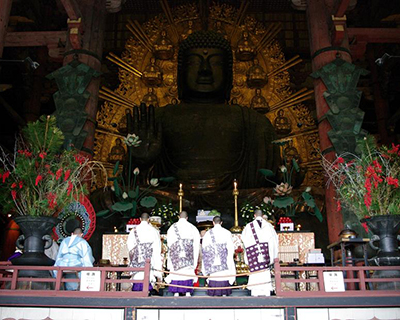
February
(Setsubun)
Festival of the First Day of Spring (Setsubun)
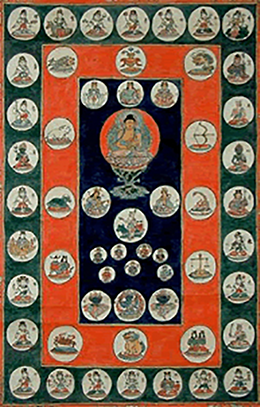
“Setsubun” is generally celebrated on Fabruary 3rd in Japan. In the area around Nigatsu-dō and Hokke-dō, the following ceremonies are held.
The ceremony of “Gengu” is held at 10:00 at Nigatsu-dō. This ceremony is to burn talismans and amulets enshrined the previous year.
”Mamemaki” (Bean throwing” is held at 14:00 after the Buddhist memorial service at Nigatsu-dō. Parched soybeans are thrown to rid the buildings of bad luck by saying, “Oni wa soto! (Out with the demon!)”, and to bring in good luck by saying, “Fuku wa uchi! (In with fortune!)”. Beans will be distributed to visitors in front of Hokke-dō.
”Hoshi (stars)-Kuyō” is held at 18:00 at Nigatsu-dō. This Buddhist service is to pray to the stars to repel evil and bring happiness. During this spectacle at Nigatsu-dō, many votive lights are lit, and the star mandala is displayed on an altar.
March
April
(Busshō-e)
Ceremony of the Buddha’s Birth (Busshō-e)
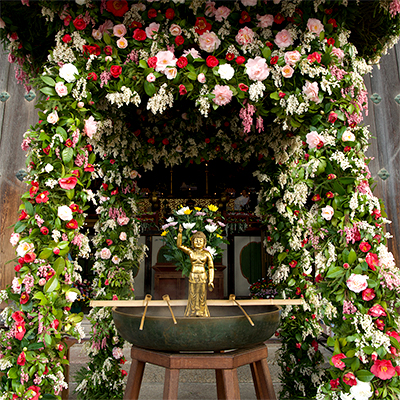
May
13:30-
13:00
Great Buddha Hall
Kagami pond
Memorial Service for Emperor Shōmu

11:00-
Ceremony of offering green tea to Great Buddha (Urasenke Sytle)
Great Buddha Hall
Visit to Emperor Shōmu’s Mausoleum
Ceremony of offering green tea to Great Buddha (Urasenke Sytle)
All monks at Tōdai-ji temple depart from the Great Buddha Hall at 8:30 and visit the Mausoleum of Emperor Shōmu and Empress Komyo and offer prayers.
Upon returning, at around 11:00 the ceremony of Kencha by Urasenke style (offering tea to Vairocana-Buddha) is held at the Great Buddha Hall.
And after the ceremony, at the east corridor of the Great Buddha Hall, green tea is distributed free of charge.
July
11:00-16:00
Memorial Service for Priest Chōgen
In order to commemorate the great accomplishments of Priest Shunjōbō Chōgen a memorial service is held at Shunjō-dō. He passed away in 1206 at the age of 86.
(Kejo-e)
Ceremony of Purification (Kejo-e)

August
(Ominugui)
Cleaning of the Great Buddha (Ominugui)

(Oyoku)
Day of Special Merit (Oyoku)
Price of 1 votive lantern: 500 Yen (1 lottery ticket is distributed)
Night special admission (free of charge)
(The gate closes once at 17:30)
(Mantō-kuyō-e)
(The gate closes once at 17:30)
Festival of Ten Thousand Lanterns (Mantō-kuyō-e)
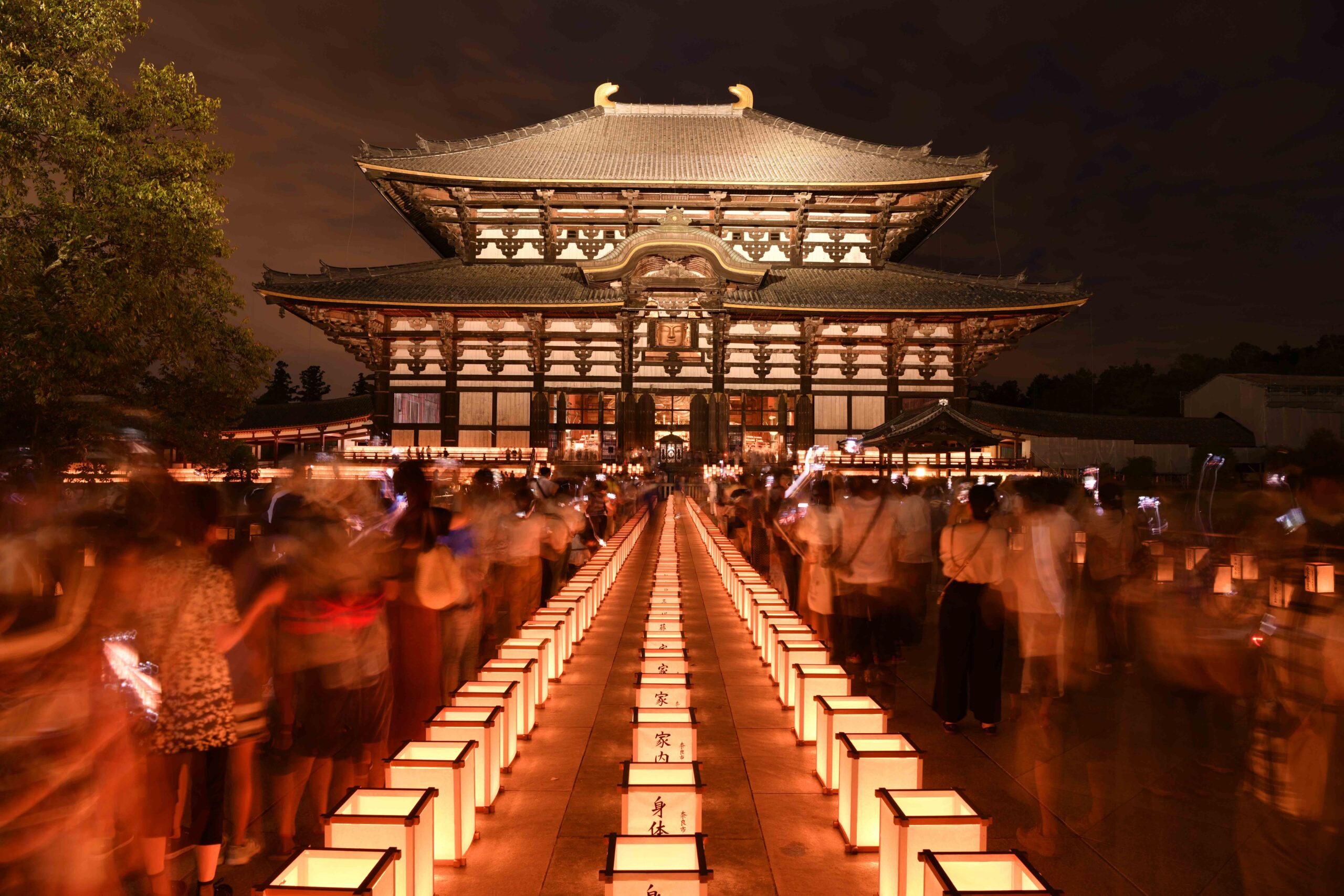
September
Day of Kannon “Jūshichiya” (The 17th night)



The 17th of every month is regarded as the day of Kannon (Kuan Yin) Bodhisattva (Goddess of Mercy), and especially on September 17th called “Jūshichiya (the 17th night)”, various memorial services and events have been held at Sacred Sites of Kannon in various parts of Japan since ancient times.
Buddhist service is held from 18:00 on this day, at Nigatsu-dō as well. And from early in the morning until around 20:00, many votive lights are lit in main hall. In the evening, about 400 lanterns painted with wishes and drawings are placed around the main hall.
From 18:30 to around 21:00, Bon-Odori Dance is also held in the square under Nigatsu-dō, and anyone can join dancing.
October
Kanjin-sho
Ceremony Celebrating the Protection of Hachiman (Tegai-e)
The name “Tegai-e” is said to have originated from the fact that when a deity from Usa Hachimangu Shrine in Ōita prefecture was invited to be a guardian deity for the construction of the Great Buddha of Tōdai-ji Temple. A portable shrine is transferred to the Tegai-mon Gate of Tōdai-ji Temple and used as a resting place. After a Shintō ritual at Tamukeyama Hachimangu Shrine, a further Shintō ritual is held to welcome the portable shrine, Mikoshi, at Tegai-mon Gate and finally a Buddhist service by Tōdai-ji priests is held. In addition, since the Meiji era, the deity, the national treasure, Hachiman in the Guise of a Monk (Sōgyō Hachiman shin zazō), has been enshrined in the Hall of the Hachiman Deity, Kanjin-sho and this secret deity image is specially unveiled on October 5th.
In Amida-dō Hall, Kanjin-sho, The Five Kalpas of Reflection by the Buddha Amida (Gokō shiyui Amida nyorai zazō) and Priest Kōkei (Kōkei Shōnin zazō)
13:30-
Kagami-ike pond
Festival Commemorating Shōmu’s Vow to Create the Great Buddha
Buddhist service & Tea ceremony
Place: Great Buddha Hall
※Please note that during the Buddhist service and tea ceremony, you cannot worship in front of the Great Buddha.
Offering Noh Performance
(Noh is a traditional form of theatre where some actors wear masks)
Date & time: From 13:30 on October 15th
Place: Kagami-ike Pond (In case of rain, it is performed at Kinshō Hall)
December
Butsumyō-e
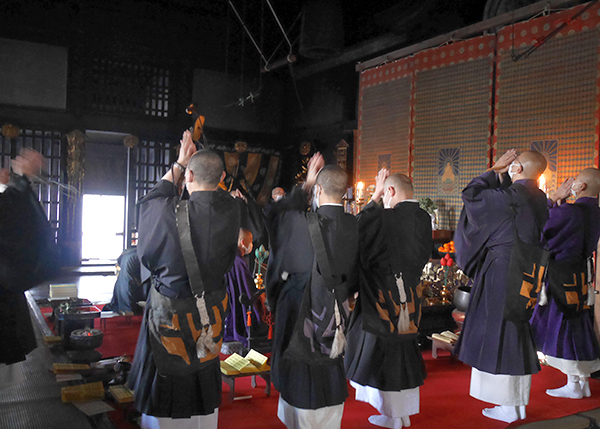

Around 10:00-16:00
Around 9:00-16:00
Hokke-dō
Shunjō-dō
The anniversary of the death of priest Rōben
Unveil of Treasured Buddhist Images
Founder’s Hall (Kaisan-dō)
The portrait statue of Rōben (Rōben Sōjyō zazō) (National Treasure)
The portrait statue of Jitchū (Jitchū Kasyō zazō)
Jitchū was the chief disciple of Rōben who founded Tōdai-ji and was the one who began the Shuni-e Ceremony at Nigatsu-dō in 752.
Hokke-dō(Sangatsu-dō)
The secret image of Shukongōjin (National Treasure)
Shunjō-dō
Standing Amida (Important Cultural Property)
Seated Aizen Myō-ō ((Important Cultural Property)

